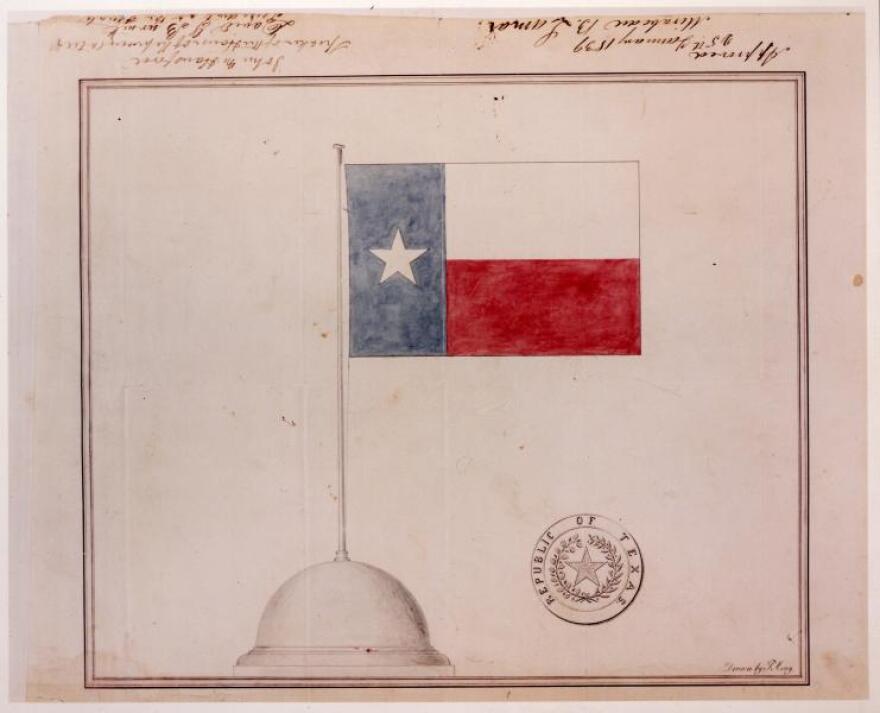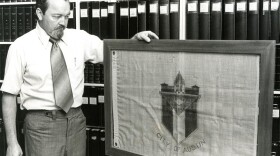This story was originally published on June 15, 2016.
Well, yesterday was flag day – a day that marks the anniversary of the adoption of the U.S. flag, Betsy Ross' famed stars and stripes design.
But, if you’re a Texas history buff, or if you’ve been to a location of a popular, national theme park, you’ll know that Texas has had six flags fly over it. Perhaps the most recognized, however, is the state’s iconic Lone Star Flag, the state’s current flag.
The problem is, like Betsy Ross’ design, nobody can say for sure who designed the Lone Star flag, and there’s been a fight for decades about whom, if any one person, did.
"The problem is – because the records of the convention are incomplete – that we have a reference that there was a design...but the design isn’t described.”
“We don’t know who designed the Texas flag,” says Charles Spain, a Houston attorney and vexillologist, which is, for the uninitiated is a person who studies flags. “I think [that] question gets into a question of how do we figure out historical truth. And, that’s a very complicated issue that frequently gets all tied up with local pride.”
More on that local pride later – back to the actual origins of the flag itself.
It was formally commissioned after the Texas Revolution when Texas was still a fledgling nation that needed a “national standard.”
The iconic flag adopted back then wasn’t the first draft by any stretch. Texans had plenty of informal drafts to run through during its rebellion against Mexico; from the iconic battle banner of Gonzales – the famous “Come and Take It” flag: – to the lesser-known Brown flag flown at the massacre at Goliad, which was basically the U.S. flag featuring a severed bloody arm holding a sword – minus the stars.
But, as the leadership of that rebellion in Texas congealed, its leaders formally organized to draft a constitution and declaration of independence at Washington-on-the-Brazos. And, for formality’s sake, they also decided to draft an official flag.
That’s where the problems started.
“You did have discussions on adopting a national flag. The problem is – because the records of the convention are incomplete – that we have a reference that there was a design on a certain date,” he says. “But, the design isn’t described.”
To be fair, there were lots of suggestions for a Texas banner.
Stephen F. Austin had two suggestions – one featured a profile portrait and pretty lengthy quote from George Washington at its heart.

Another featured, the tri-color red, white and green of Mexico – both folded in the Union Jack of the UK’s flag. They were met with skepticism.

But, two other, more successful, proposed designs featured a single lone star. Some assume one of them is what’s known as the “Lorenzo de Zavala flag,” a flag with a white star on a blue field with “Texas” surrounding the star, which is (wrongly) credited as the first flag of Texas. Another is – technically – what later became the first national flag of Texas, the David G. Burnet flag – a similar design featuring a single gold star on a blue field.

And while they discussed adding “Texas” around the center star of the flag they were discussing, it’s unclear which flag they were referring to, and, it seems, there was another addition – a rainbow.
"Yeah that’s in the discussion. But, that bill itself in front of the convention is never adopted, to the best of our knowledge, because the records aren’t there," Spain says. "So, nobody knows what that design was because nobody knows what the first design was that the letters T-E-X-A-S were added to."

For the record, the motion also suggested adding a second, six-pointed star in the flag’s western horizon, in addition to that rainbow.
Of those two flags in question, the Burnet flag – the blue field and gold star, without “Texas” encircling it – was used throughout the rest of the Texas Revolution. It formally became the first national standard of Texas when it was ratified by the Republic of Texas in December of 1836. But, in 1839, Mirabeau B. Lamar, the second president of the Republic of Texas ratified a new state flag.
Here’s where it gets familiar for a lot of former fourth and seventh grade Texas social studies students – the Lone Star flag is often synonymous with a single name: Charles B. Stewart, a lawmaker, signer of the Texas Declaration of Independence and a founding father of modern Texas, who, some say, designed the Texas flag.
This is where that local pride comes in.

Pat Spackey a luminary of City of Conroe in Montgomery County, she's involved in a whole host of heritage and history organization, and she's the great, great, great granddaughter of Charles Bellinger Stewart.
"A committee was assigned to this project and Dr. Stewart designed the Lone Star flag on a piece of oil linen and colored it with red and blue pencil," she says, adding that she's heard plenty of people, like Spain, suggest that the designer of the flag is unknown.
"And that just, of course, upsets not only the people of Montgomery County, but also the descendants of Charles B. Stewart, who feel very strongly that it is true," Spackey says.
Spackey was intimately involved with the City of Conroe's 2011 park project that honors Stewart as the flag's sole designer.
The town of a library honoring Stewart, a bust of Stewart – which Spackey penned the engraving for – and a park honoring some of the early flags of Texas, including that one with the severed arm I mentioned earlier.

The bust of Stewart in the park reads: "Charles Bellinger Stewart designed the world famous LONE STAR FLAG OF TEXAS which was adopted in 1839."
Spain says Stewart didn't design the flag, and that it was designed by committee – a committee that, because the records are incomplete, never explicitly said Charles B. Stewart was the lone designer of the Lone Star flag, or even that he was on the committee, though, many suspect he was.
"It’s one of those things in Texas history that isn’t perfectly confirmed, but we’re going with it."
Spain says it’s similar to the American flag, that the Texan and American flags’ narratives, and aesthetics, are pretty much cut from the same cloth.
"It’s much like the Betsy Ross story," he says. "It’s a creation of her children and grandchildren, and the Charles Stewart story is a creation of his descendants.”
The stories of Stewart and Ross have been debated since their inception, simply because those people never flat out said, “Hey, I made this flag.” At least, if they did, there’s no written record of it.
Spackey says the story of Charles Stewart was something that’s been in her family since she could remember, along with that piece of linen that has the Mirabeau B. Lamar signature, which Stewart’s family donated to the state in 1966.

But the Texas State Library and Archives Commission says the Lone Star Flag was likely designed by Austin Artist Peter Krag for $200.

Spackey says she knows all about the Krag design, but says that Krag was commissioned to draw it – he wasn't the brains behind the design. Still, that piece of linen her family gave to the state in 1966 has been hard to authenticate. It was laminated by Spackey's family in the ‘60s, it has water colors that are dated to a time after Stewart’s death and, some have said, it could be a tracing, an assertion Spackey says she's never heard.
"Now, I’ve never heard that because we’ve always, as I said, had a copy of the original," she says. "And, then, I know that my cousin, she was the one who did all the history and she was the one who did present that to the archives in Austin.”
Her cousin, Virginia Lindley Ford, personally handed the linen over to the state, and when she says she wrote the history, she means it. Ford authored Stewart's entry in the Handbook of Texas, and she lobbied the legislature against Spain to secure Stewart’s recognition – both had varying degrees of success.
One session the legislature passed a resolution saying Charles Stewart created the Lone Star flag, only to come back and revise that recognition to say it’s unclear who created it – largely because of Spain’s research on the subject.
In 1997, Ford passed away. Spain says he thinks she died hating him.
But, he says, he can’t simply accept the narrative Pat Spackey and her cousin have put forth. There’s not evidence to confirm or deny it.
“It devalues Texas history because it may be that someday we find the answer in historical evidence and correspondence and it might be Charles Stewart! It very well could be," he says. "Maybe he did design it. Maybe somebody else designed it. What I think is likely is that the design of the Texas flag came from several sources in the same period of time and that there isn’t necessarily a designer.”
Spackey admits it might be murky, but she and her family are sticking by their side of the story.
"It’s one of those things in Texas history that isn’t perfectly confirmed, but we’re going with it. That’s why we’re passing it on from generation to generation to our family," she says.
And, while it may never be revealed who exactly the Lone Star Flag's designer is, it's abundantly clear where it's design influence comes from:








